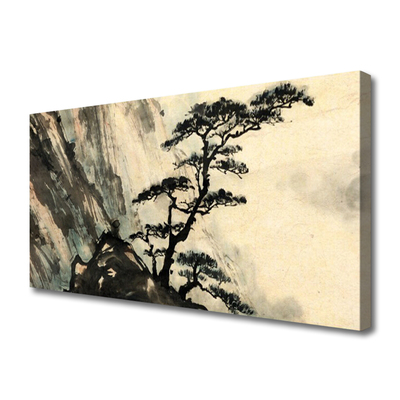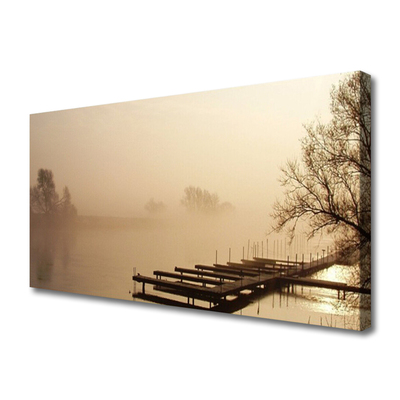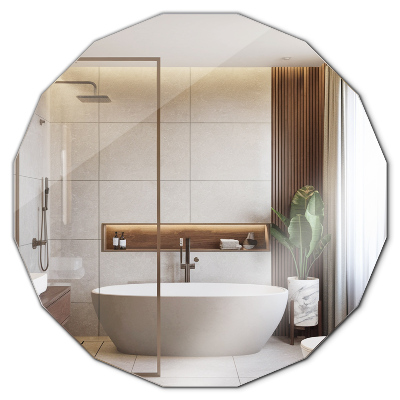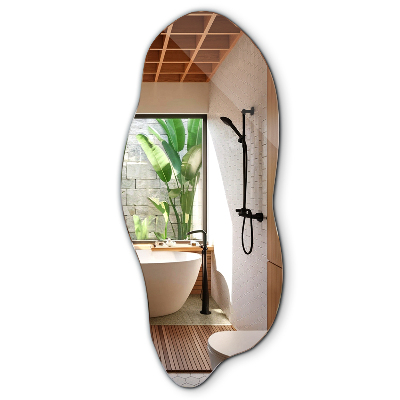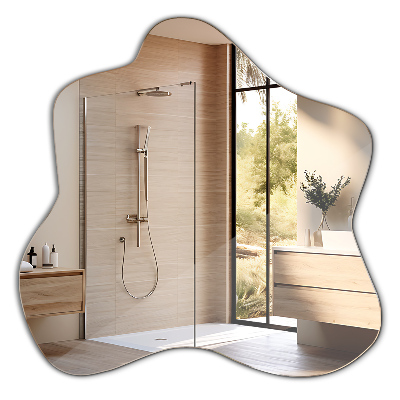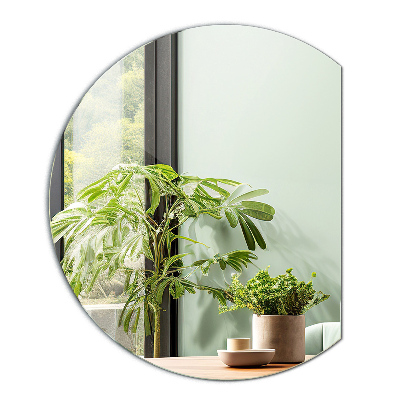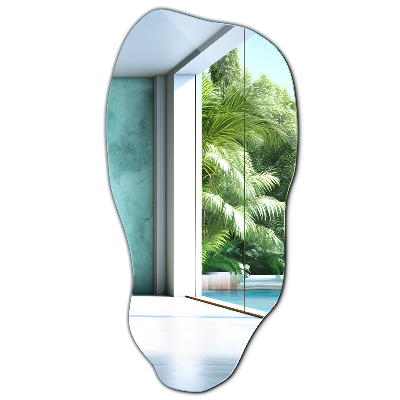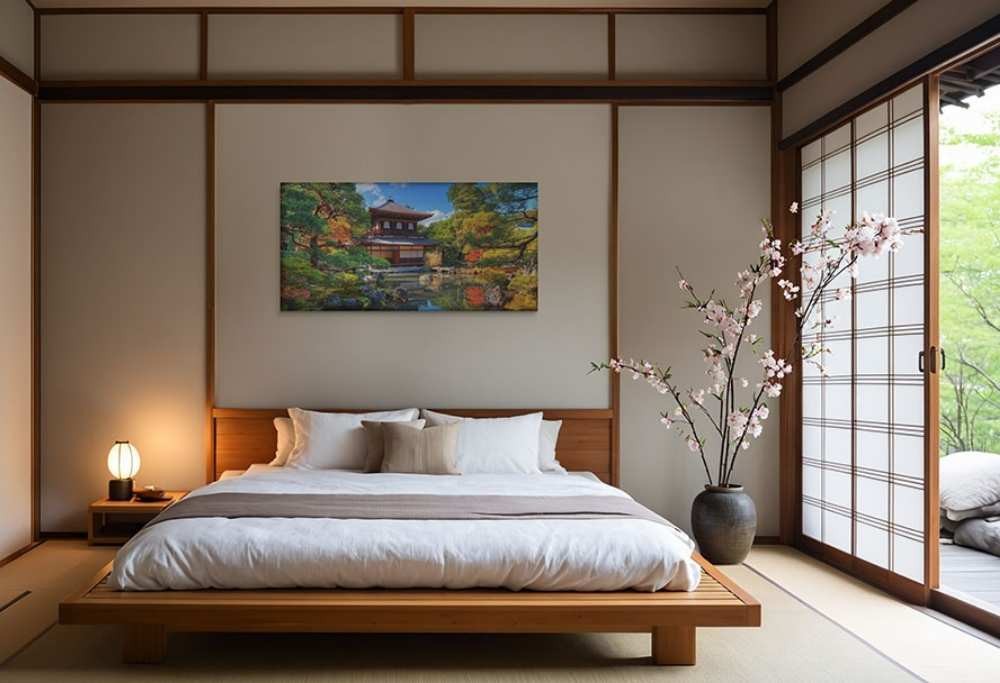
The Japanese style in interior design has been admired for years for its simplicity, harmony, and love of nature. A Japanese-style room is not just about aesthetics—it’s a philosophy of life that emphasizes inner peace, balance, and living in harmony with nature. Interiors designed in this spirit reflect a minimalist approach to space, eliminating unnecessary clutter and incorporating natural materials that soothe the senses.
If you dream of designing a Japanese-style room and bringing the spirit of Japan into your home, this guide will help you every step of the way. It’s more than just a style—it’s a way to embrace a daily life full of positive energy.
Colors That Calm – The Natural Palette of Japanese Interiors
The Japanese style is dominated by muted colors inspired by the landscape—beige, gray, white, subdued greens, and soft wood tones. This monochromatic decor creates a tranquil and harmonious space. Unlike the abundance of colors in boho or eclectic styles, the Japanese style is defined by purity of form and an absolute minimum of colors.
Natural light streaming through large, uncovered windows beautifully highlights natural materials—wood, bamboo, linen. To enhance the atmosphere, consider zen-inspired decorations, such as canvas art featuring Mount Fuji, cherry blossoms, or subtle calligraphy. These accents don’t disrupt the order but gently complement it. A mirror in a simple form, free of unnecessary embellishments, reflecting natural light, is also a great choice—especially if placed opposite a light source.
In Japanese-style interior design, every element should serve a purpose and maintain balance. The space should breathe and not feel overcrowded—just like in traditional Japanese style, where every object has its place and meaning.
Less Is More – Japanese Interior Design
Minimalism in Japanese style does not mean emptiness—it’s quite the opposite. It’s a conscious choice of only those elements that are necessary and beautiful in their simplicity. Japanese homes feature primarily functional solutions that promote order and inner harmony.
At the center of the room, you’ll often find a low coffee table in a simple design, surrounded by soft floor cushions or low seating furniture. Geometric shapes, the absence of excessive decorations, and natural material seating instead of traditional chairs define Japanese-style interior design—minimalist but not austere.
Rooms inspired by the Land of the Rising Sun must include Japanese screens made of wood and rice paper. These not only divide the space but also add subtle charm. To complete the style, a frameless mirror hung on the wall in a strategic spot can add lightness and reflect natural light, visually enlarging the space.
This minimalist Japanese style blends perfectly with modern Scandinavian design—both emphasize functionality, light, and nature.
Materials Inspired by Nature – Wood, Bamboo, and Fabrics in Japanese Style
Natural materials are the cornerstone of Japanese-style interior design. Wood—especially light wood—is omnipresent: in furniture construction, flooring, decorative frames, or blinds. Wooden floors, "tatami" mats, or simple bamboo shelves are essential elements of Japanese homes.
Fabrics also play a significant role—choose linen, cotton, silk, and other natural weaves. Curtains, throws, mats, or cushions should be understated and unobtrusive. A paper lantern made from rice paper hanging in the center of the room will diffuse light and create a unique atmosphere of tranquility.
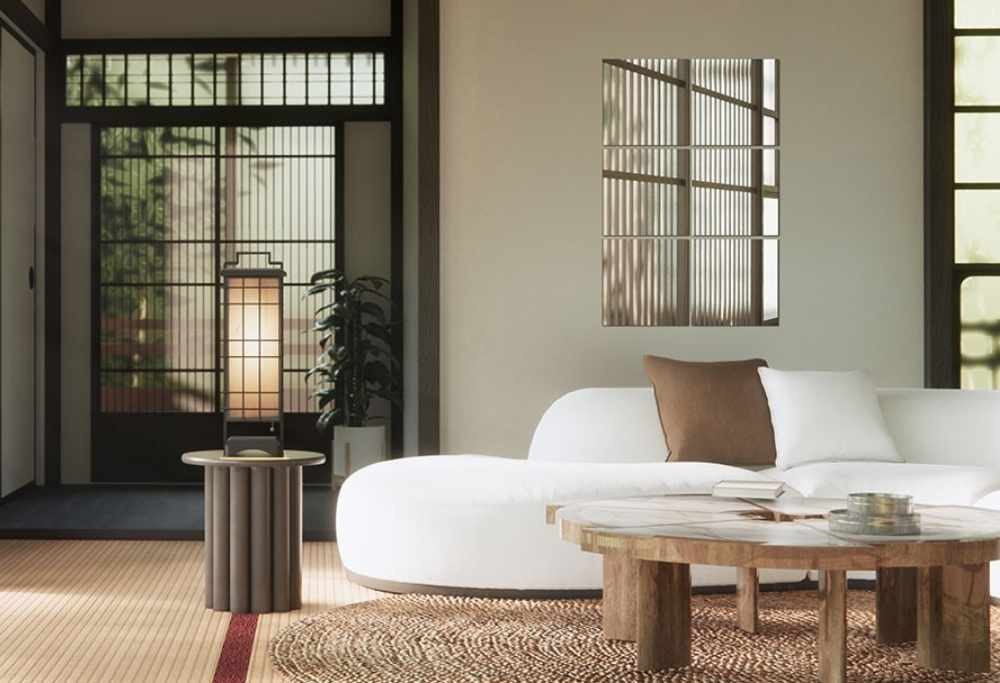
Don’t forget about accessories—ceramic vases, stone bowls, or modest succulent pots or a miniature bonsai tree. These accents not only complement the Japanese-style interior but also emphasize the connection with nature.
The Japanese style in interior design combines functionality with natural beauty—where quality and thoughtful design take precedence over ornamentation, working in harmony with the room’s energy according to feng shui principles.
Light and Space – Open the Room to Quiet
In Japanese interiors, light plays a unique role—it sets the mood, highlights the beauty of natural materials, and influences the sense of space. In traditional Japanese homes, windows are large, often sliding, made of wood and rice paper. This approach allows for the subtle diffusion of daylight, enveloping the interior in a soft glow.
In a Japanese-style interior, it’s worth forgoing heavy curtains or blinds in favor of lightweight bamboo shades or linen curtains. A paper lantern hung centrally or several smaller light sources strategically placed—for instance, in the corners of the room—will create a warm atmosphere without feeling overwhelming.
Natural light can also be enhanced by mirrors—preferably simple and frameless—placed to reflect sunlight and bring positive energy into the room. This technique not only visually enlarges the space but also helps maintain harmony in line with feng shui principles.
The Japanese style is also characterized by a mindful use of space—no furniture in the middle of the room, open passages, clean lines. This ensures that the interior “breathes,” making the home a place of tranquility and focus.
Details Straight from the Land of the Rising Sun
In the Japanese style, nuances matter—every detail counts, and accessories are not random. While a Japanese-style room avoids excessive decorations, carefully selected decorative elements can completely transform the space.
An essential part of bedroom or living room decor could be canvas art inspired by Japanese culture—minimalist mountain motifs, cherry branches, geometric forms, or calligraphy will bring the spirit of Japan into your interior. Their presence doesn’t disrupt the monochromatic decor but rather emphasizes it.
Consider natural accents—ceramic vases, stone trays, wooden decorations. These small touches not only bring elements of nature but also pay homage to traditional Japanese homes.
Unnecessary clutter is replaced with items that have a story, crafted by hand, preferably from local materials. The Japanese style in interior design respects simple but thoughtful objects—those that stay with us longer and create an emotional connection with the space.
The Japanese Style in Interior Design – The Art of Living in Harmony
When designing a Japanese-style room, you’re embracing more than just inspiration from the Far East. It’s an invitation to a different rhythm of life—calmer, more mindful, and closer to nature. The Japanese style in interiors is a story of simplicity that doesn’t bore but soothes the senses. It’s the ability to see beauty in subtleties and live surrounded by things that truly matter.
Your home can become a space where daily life takes on a new dimension. Just a few thoughtful changes can invite the spirit of Japan into your interior. Let this harmony settle not only in your decor but also in your everyday life.



